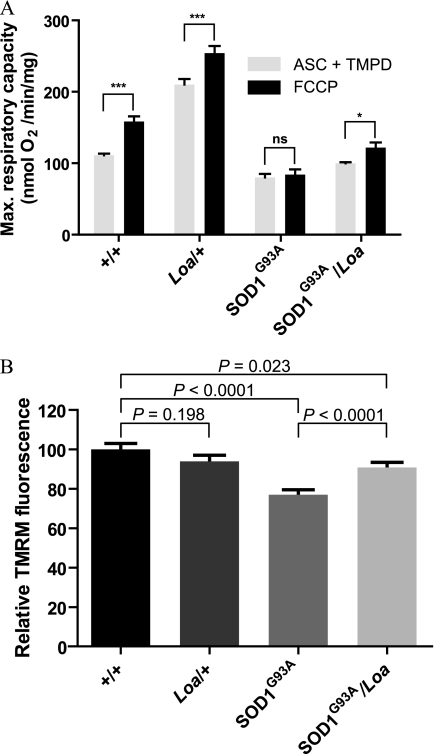FIGURE 4.
Loa mutation ameliorates defects in oxygen consumption rate and membrane potential of SOD1G93A mitochondria. A, brain mitochondria were purified from homogenates in TWB buffer supplemented with 1% bovine serum albumin and 7 mm l-cysteine hydrochloride monohydrate as described under “Experimental Procedures.” Oxygen consumption rates of mitochondria were measured in an oxygen electrode in the presence of ascorbate (ASC) and tetramethyl-p-phenylenediamine (TMPD; gray bars). Respiration was stimulated by the addition of 1 μm FCCP (black bars). As expected, the addition of FCCP significantly stimulated oxygen consumption in +/+ (p < 0.001) and Dync1h1Loa/+ (p < 0.001). SOD1G93A mitochondria, on the other hand, failed to produce any significant response to FCCP. However, SOD1G93A/Loa mitochondria showed increased respiration after the addition of FCCP, which was statistically significant (p < 0.05). Two-way analysis of variance (degrees of freedom = 15) followed by Bonferroni post tests were used for statistical analysis of these data. ns, not significant. *, p < 0.05; ***, p < 0.001. B, mitochondria in motor neurons from SOD1G93A mice are depolarized, but this effect is abolished in motor neurons of SOD1G93A/Loa mice. TMRM is a potentiometric indicator with a single delocalized positive charge, and thus, it becomes sequestered in mitochondrial as a result of the electrochemical potential gradient that exists between the cytosol and mitochondria. Using TMRM and confocal microscopy, mitochondrial membrane potentials (ΔΨm) were measured in cultured motor neurons isolated from E13 embryos of each genotype. The ΔΨm of SOD1G93A motor neurons was 23% lower than the ΔΨm of motor neurons from wild-type littermates (p < 0.001), indicating that mitochondria from SOD1 motor neurons are depolarized. However, in motor neurons from SOD1G93A/Loa mice, ΔΨm was 10% lower (p = 0.023) than that in motor neurons of wild-type littermates, indicating that the Loa mutation is able to ameliorate the defect in ΔΨm present in SOD1G93A motor neurons.

